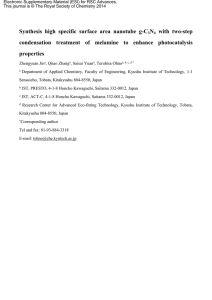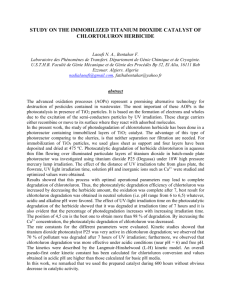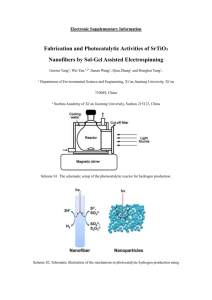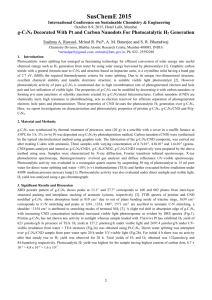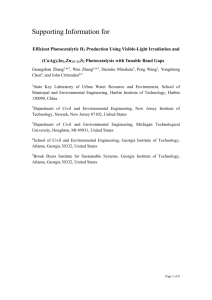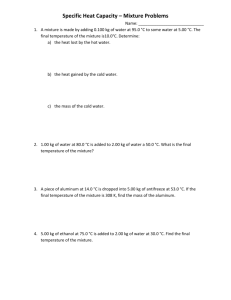Electronic Supplementary Information Pd Nanoparticles Supported
advertisement
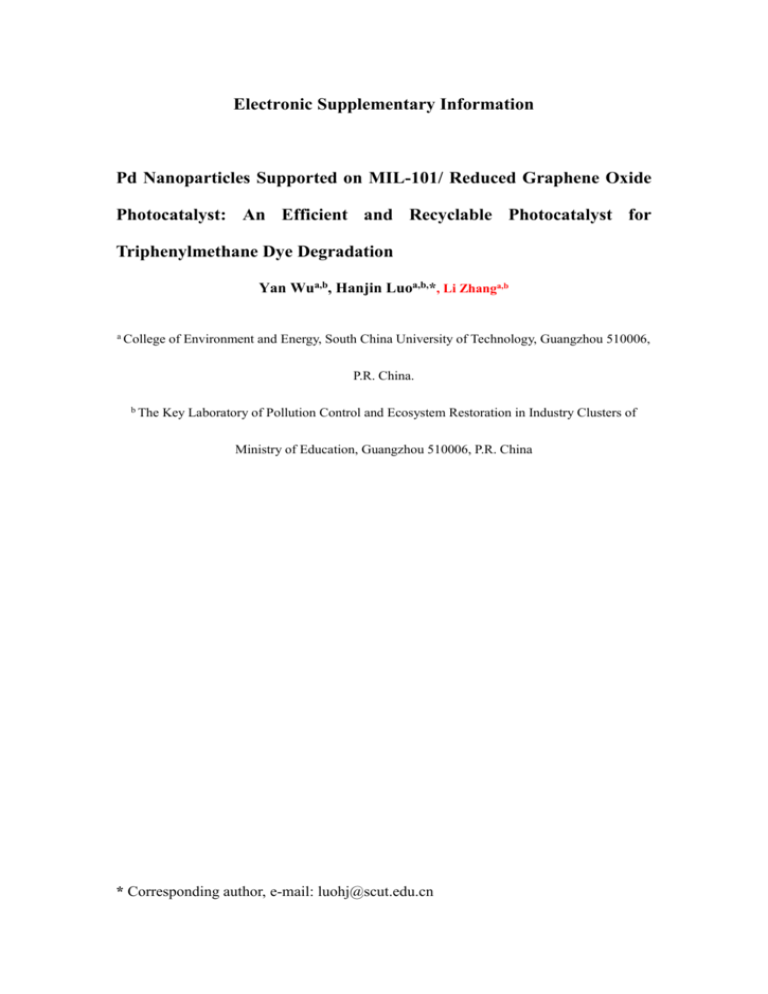
Electronic Supplementary Information Pd Nanoparticles Supported on MIL-101/ Reduced Graphene Oxide Photocatalyst: An Efficient and Recyclable Photocatalyst for Triphenylmethane Dye Degradation Yan Wua,b, Hanjin Luoa,b,*, Li Zhanga,b a College of Environment and Energy, South China University of Technology, Guangzhou 510006, P.R. China. b The Key Laboratory of Pollution Control and Ecosystem Restoration in Industry Clusters of Ministry of Education, Guangzhou 510006, P.R. China * Corresponding author, e-mail: luohj@scut.edu.cn Materials: Solvents and all other chemicals were obtained from commercial sources and were used as received unless otherwise noted. Graphite was obtained from Qingdao Ruiying Co. Ltd., China. Chromium (III) nitrate nonahydrate, 1, 4-benzene dicarboxylic acid (H2BDC), potassium hexachloropalladate (IV) were obtained from Sigma-Aldrich Co. LLC (Shanghai, China). All solutions were prepared using deionized (DI) water. Preparation of GO: GO was synthesized from natural graphite by a modified Hummers method according to our previous reports. Graphite (5.0 g) and NaNO3 (2.5 g) were mixed with 120 mL of H2SO4 (98%) in a 500 mL beaker. The mixture was stirred for 30 min in ice bath. While maintaining vigorous stirring, potassium permanganate (15.0 g) was added to the suspension. The rate of addition was carefully controlled to keep the reaction temperature lower than 288 K. After 90 min, the ice bath was removed and the mixture was stirred at 308 K for 30 min. As the reaction progressed, the mixture gradually became pasty and the color turned into light brownish. At the end, 230 mL of deionized water was slowly added to the paste with vigorous agitation. The reaction temperature rapidly increased, and the color changed to yellow. The diluted suspension was stirred at 371 K for 30min. Then, 30 mL of 30% H2O2 was added to the mixture. For purification, the mixture was centrifuged with 5% HCl then deionized water several times, and finally freeze-dried under vacuum for 24 h. Characterization: Transmission electron microscope (TEM) images were obtained using a PHILIPS (Nederland) TECNAI 10 TEM at different magnifications with an accelerating voltage of 100 kV. The X-ray diffraction (XRD) patterns were recorded using a Bruker D8-advance X-ray diffractometer at 40 kV and 40 mA. A Cu Kα radiation (λ=1.5418 Å) source was used in the X-ray tests. All patterns were collected at a scanning rate of 0.020◦/step and 17.7 s/step, 2θ ranging from 5◦ to 90◦. The X-ray photoelectron spectroscopy (XPS) measurements were conducted with an Axis Ultra DLD spectrometer (Kratos Analytical Ltd., England) with a monochromatized Al Kα X-ray source (hν=1486.6eV). UV-vis diffuse reflectance spectra (DRS) were measured over the spectral range 200–800 nm on a Cary 300 UV/Vis spectrophotometer (Agilent, USA). Photocatalytic degradation of triphenylmethane dye: The photocatalytic activities of MIL-101 and Pd/MIL-101/rGO photocatalysts for brilliant green and acid fuchsin were evaluated in a photo-reactor under visible-light irradiation using a 500 W xenon lamp (CHF-XM500, light intensity = 600 mW/cm2) through UV cut-off filters to completely remove any irradiation below 420 nm and to ensure illumination by visible-light only. The photocatalytic experiment was performed in natural atmosphere, without any external source of aeration. The photocatalytic experiments were conducted in triplicate and the final data used for mapping were the average of the collected experimental data. The maximum errors were less than 5%. In each experiment, 50 mg catalyst was added into 200 mL aqueous solution of brilliant green (25 mg/L) or acid fuchsin (25 mg/L). Prior to the photocatalytic reaction, the suspension was placed in the dark for 30 min with magnetic stirring before irradiation to ensure the establishment of an adsorption–desorption equilibrium. The suspension was sampled at a given interval of time and analyzed by recording brilliant green or acid fuchsin concentration with the UV–vis spectrophotometer (UV-1750, SHIMADZU, Japan) at an absorbance wavelength of 625 or 544 nm, respectively. The normalized concentration of brilliant green or acid fuchsin after irradiation was calculated as Ct/C0, where C0 represents the concentration at the adsorption–desorption equilibrium of the photocatalyst before illumination, Ct is the concentration of brilliant green or acid fuchsin measured after irradiation at a particular interval of time.
